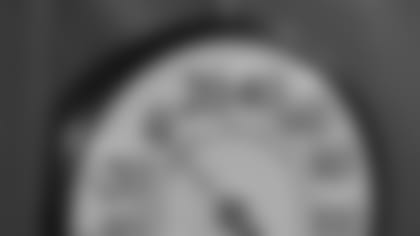Cold weather. The frozen tundra.
They're as much a part of Packers history as Super Bowls and bleacher seats, so here's a list of the 10 coldest games in franchise history. Well, more accurately, they're the 10 coldest dating back to Vince Lombardi's first season as head coach in 1959, the year the team began officially recording game temperatures.
For this list, double-digits need not apply. Too balmy. Seven of the 10 were played at Lambeau Field. More of them might have been road games had division rivals Minnesota and Detroit not been playing in domes for so long.
These 10 are ranked objectively, in descending order of kickoff temperature. In the event of a tie, the most recent game is described first.
In any case, the top game still resides where it should.
10. Nov. 28, 1976, vs. Chicago, 6 degrees
One of three contests quarterback Carlos Brown started for the Packers late in the '76 season, this was the coldest game of Bart Starr's tenure as head coach until the final one seven years later.
Green Bay's John Brockington managed just 15 rushing yards on 13 carries while Chicago's Walter Payton compiled 110 yards on 27 tries. The Packers tied it at 10 on Brown's 11-yard TD pass to Ken Payne in the third quarter, but when Brown was intercepted for the second time early in the fourth quarter, his 5-for-17 day was done and he was replaced by Randy Johnson, who was sacked and lost a fumble on his only drive into Bears territory.
All in all, a forgettable 16-10 defeat.
9. Dec. 7, 2008, vs. Houston, 3 degrees
The Packers' playoff hopes were on life support at 5-7, but the theory was a late-season surge could begin with a Texas team coming north to play in single-degree temps.
That theory didn't pan out. Unfazed by the cold and a balky knee, Houston quarterback Matt Schaub threw for 414 yards, third most in Lambeau Field history, and drove the Texans 75 yards over the final 1:49 to a game-winning field goal as time expired in a 24-21 decision.
8. Jan. 12, 1997, vs. Carolina, 3 degrees
This NFC Championship was the first title game in Green Bay since the "Ice Bowl," and the weather was fitting, with the wind chill minus-17 at kickoff and minus-23 later in the game.
The field, ruined the previous week by a rain-and-mud-filled playoff victory over San Francisco, was replaced in less than a week by sod trucked in from Maryland on more than two dozen semis.
The Packers fell behind 7-0 early but dominated the rest of the way, putting up 479 yards of offense. Running back Dorsey Levens accounted for 205 of them (88 rushing, 117 receiving), and his acrobatic, 29-yard touchdown catch near the front pylon of the south end zone preceded the Packers' 10 points in the final minute of the first half. The 30-13 triumph sent the Packers to their first Super Bowl in 29 years.
7. Dec. 18, 1983, at Chicago, 3 degrees
In what turned out to be Starr's last game as head coach, the Packers missed a chance to tie for the NFC Central title and possibly make the playoffs when the Bears drove 58 yards for a 22-yard, game-winning field goal by Bob Thomas with 10 seconds left.
Green Bay quarterback Lynn Dickey connected on just 10 of 30 passes and had four interceptions at Soldier Field that day, but the 10 completions covered 262 yards and his 5-yard TD pass to tight end Paul Coffman with 3:18 left had given the Packers a 21-20 lead.
Thomas had missed a 38-yard field goal early in the third quarter, but he made good when given a shot at redemption. Had he not, Starr might have coached a 10th season, and beyond, in green and gold.
6. Dec. 22, 2008, at Chicago, 2 degrees
The Packers were trying to spoil the Bears' playoff chances in what became a very entertaining Monday night game at Soldier Field.
With the wind chill at minus-13, the Packers pulled out all the stops, with rookie QB Matt Flynn executing a fake punt to help set up a touchdown. The Bears tied the game at 17 on Matt Forte's 3-yard TD run with 3:11 left, and then Chicago's Alex Brown blocked Mason Crosby's 38-yard field goal try with 18 seconds left in regulation to send the game to overtime.
The Bears won the toss and scored right away, with Robbie Gould's 38-yard kick the game-winner, marking the second time in a frustrating 6-10 season that the Packers lost in overtime without ever getting the ball.
5. Dec. 22, 1990, vs. Detroit, 2 degrees
The first of Blair Kiel's two career starts at quarterback for the Packers nearly produced a victory. Kiel threw for 239 yards and ran for a 3-yard score, and rookie running back Darrell Thompson ran a kickoff back 76 yards for a touchdown as Green Bay took a 17-10 lead after three quarters.
But a fumble by tight end Ed West was scooped up and returned 22 yards for a touchdown by cornerback Ray Crockett, running back Barry Sanders capped a 133-yard day with a 6-yard TD run, and Crockett intercepted Kiel at the goal line with 1:39 left as Detroit triumphed, 24-17, one of five straight losses to end the season for the Packers.
4. Dec. 26, 1993, vs. L.A. Raiders, 0 degrees
The Packers clinched a playoff berth for the first time in over a decade and began a Lambeau tradition that's still going strong, all on a frigid, post-Christmas afternoon.
In a 28-0 drubbing of a southern California squad that wanted nothing to do with the minus-22 wind chill, defensive end Reggie White recovered a Raiders fumble and lateraled the ball to safety LeRoy Butler, who took it the final 25 yards for the score.
Butler subsequently jumped into the stands in the south end zone, the first occurrence of what is now known as the "Lambeau Leap."
3. Dec. 10, 1972, at Minnesota, 0 degrees
In the driver's seat for the NFC Central title and their first playoff berth since the Lombardi era, the Packers clinched both in the minus-18 wind chill at Metropolitan Stadium in Bloomington, Minn.
Trailing 7-0 at the half, Green Bay took control with a 17-point third quarter as quarterback Scott Hunter and running back MacArthur Lane both scored on short runs. Lane and Brockington combined for 213 rushing yards while the defense held the Vikings to just 144 total yards and forced turnovers on all four Minnesota possessions in the second half. That included three interceptions of Fran Tarkenton, two by Willie Buchanon, in the 23-7 victory.
2. Jan. 20, 2008, vs. N.Y. Giants, minus-1
What ranks as the third-coldest contest in NFL Championship game history ended up sending the Giants on to their upset of the unbeaten Patriots in Super Bowl XLII.
The way the ball was bouncing in the minus-23 wind chill, though, it seemed the Packers were the team of destiny. A rare New York defensive breakdown resulted in a 90-yard TD pass to Donald Driver in the second quarter. R.W. McQuarters intercepted Brett Favre in the red zone, only to have the ball stripped and recovered by Mark Tauscher, setting up the game-tying field goal early in the fourth.
Then Giants kicker Lawrence Tynes missed on two potential game-winning field goal attempts late in the fourth quarter, sending the game to overtime, and the Packers won the toss. But Favre's final pass as a Packer was picked off by Corey Webster, and Tynes finally delivered, 23-20.
1. Dec. 31, 1967, vs. Dallas, minus-13
The play, "35 wedge," wasn't drawn up as a quarterback sneak, but Starr ran it that way, plunging over the goal line with 13 seconds left in minus-46 wind chill for a 21-17 victory that sent the Packers to Super Bowl II.
People often forget that the game probably shouldn't have been as dramatic as it was. Starr hit Boyd Dowler for two touchdown passes in the first half for a 14-0 lead, but the Cowboys were able to rally thanks to a fumble return for a score and a halfback option pass for a 50-yard TD.
Then it was up to Starr again late in the fourth quarter. Twelve plays, 68 yards, and immortality.















